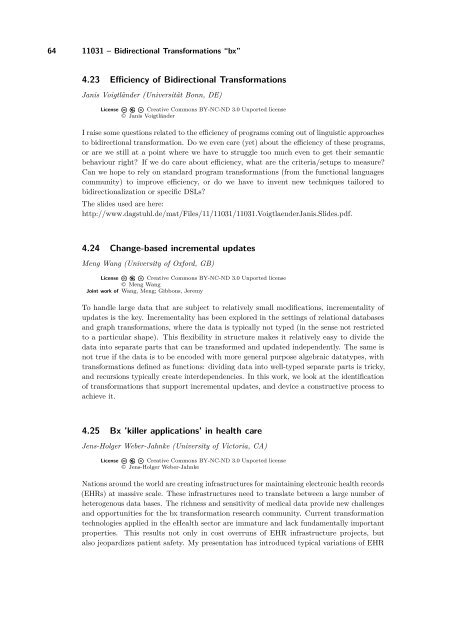Volume 1, Issue 1, January 2011 - DROPS - Schloss Dagstuhl
Volume 1, Issue 1, January 2011 - DROPS - Schloss Dagstuhl
Volume 1, Issue 1, January 2011 - DROPS - Schloss Dagstuhl
Create successful ePaper yourself
Turn your PDF publications into a flip-book with our unique Google optimized e-Paper software.
64 11031 – Bidirectional Transformations “bx”<br />
4.23 Efficiency of Bidirectional Transformations<br />
Janis Voigtländer (Universität Bonn, DE)<br />
License Creative Commons BY-NC-ND 3.0 Unported license<br />
© Janis Voigtländer<br />
I raise some questions related to the efficiency of programs coming out of linguistic approaches<br />
to bidirectional transformation. Do we even care (yet) about the efficiency of these programs,<br />
or are we still at a point where we have to struggle too much even to get their semantic<br />
behaviour right? If we do care about efficiency, what are the criteria/setups to measure?<br />
Can we hope to rely on standard program transformations (from the functional languages<br />
community) to improve efficiency, or do we have to invent new techniques tailored to<br />
bidirectionalization or specific DSLs?<br />
The slides used are here:<br />
http://www.dagstuhl.de/mat/Files/11/11031/11031.VoigtlaenderJanis.Slides.pdf.<br />
4.24 Change-based incremental updates<br />
Meng Wang (University of Oxford, GB)<br />
License Creative Commons BY-NC-ND 3.0 Unported license<br />
© Meng Wang<br />
Joint work of Wang, Meng; Gibbons, Jeremy<br />
To handle large data that are subject to relatively small modifications, incrementality of<br />
updates is the key. Incrementality has been explored in the settings of relational databases<br />
and graph transformations, where the data is typically not typed (in the sense not restricted<br />
to a particular shape). This flexibility in structure makes it relatively easy to divide the<br />
data into separate parts that can be transformed and updated independently. The same is<br />
not true if the data is to be encoded with more general purpose algebraic datatypes, with<br />
transformations defined as functions: dividing data into well-typed separate parts is tricky,<br />
and recursions typically create interdependencies. In this work, we look at the identification<br />
of transformations that support incremental updates, and device a constructive process to<br />
achieve it.<br />
4.25 Bx ’killer applications’ in health care<br />
Jens-Holger Weber-Jahnke (University of Victoria, CA)<br />
License Creative Commons BY-NC-ND 3.0 Unported license<br />
© Jens-Holger Weber-Jahnke<br />
Nations around the world are creating infrastructures for maintaining electronic health records<br />
(EHRs) at massive scale. These infrastructures need to translate between a large number of<br />
heterogenous data bases. The richness and sensitivity of medical data provide new challenges<br />
and opportunities for the bx transformation research community. Current transformation<br />
technologies applied in the eHealth sector are immature and lack fundamentally important<br />
properties. This results not only in cost overruns of EHR infrastructure projects, but<br />
also jeopardizes patient safety. My presentation has introduced typical variations of EHR













